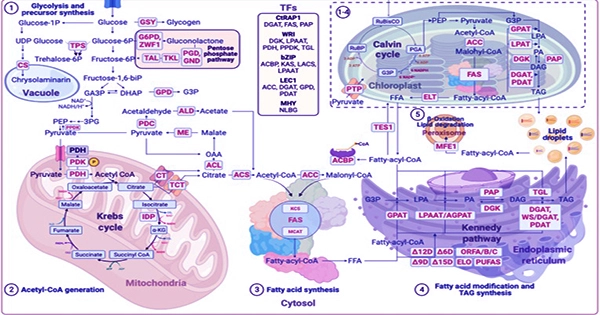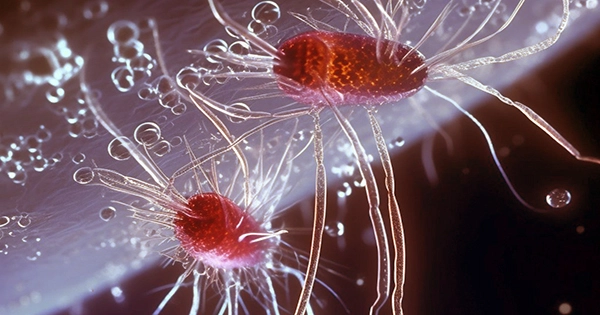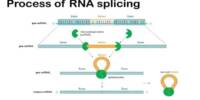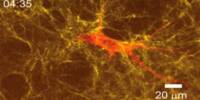Cyanobacteria are an important species in Earth’s history since they were the first to introduce atmospheric oxygen. As a result, studying their evolution provides vital insights into the genesis of modern aerobic environments. For a long time, a form of fossil lipid known as 2-methylhopanes was thought to be an essential biomarker for Cyanobacteria in sediments dating back hundreds of millions of years.
This was called into question when it was discovered that not only Cyanobacteria but also Alphaproteobacteria, are genetically capable of generating these lipids.
An international research team led by Yosuke Hoshino of the GFZ German Research Centre for Geosciences and Benjamin Nettersheim of the MARUM—Center for Marine Environmental Sciences at the University of Bremen has now studied the phylogenetic diversification and distribution of the genes—including HpnP—responsible for the synthesis of the parent lipids for 2-methyl-hopanes:

They discovered that HpnP was present in the last common ancestor of Cyanobacteria more than two billion years ago, whereas the gene only arose in Alphaproteobacteria about 750 million years ago. In the interim, 2-methylhopanes can serve as an unambiguous biomarker for oxygen-producing Cyanobacteria.
The study, published in the journal Nature Ecology & Evolution, demonstrates how genetics, in collaboration with sedimentology, paleobiology, and geochemistry, can improve biomarker diagnostic value and refine early ecosystem reconstruction.
The importance of cyanobacteria in Earth’s history: Cyanobacteria were critical in changing the Earth from an oxygen-free state to a modern, oxygen-rich environment capable of supporting increasingly complex life.
For long stretches of the Precambrian (the first four billion or so years of Earth’s history, from its beginnings to around 540 million years ago), cyanobacteria were likely the only relevant group of organisms that converted inorganic substances into organic ones (so-called primary producers) and produced oxygen.
As a result, comprehending the joint history of life and Earth requires a thorough examination of their evolution.
The importance of fossil lipids as biomarkers: In theory, the fossilized remnants of complete Cyanobacteria can be used to determine the occurrence of oxygenic photosynthesis in the geological past. However, because of preservational biases and uncertainties in identifying fossil cyanobacterial cells, geochemists prefer to use fossilized diagnostic lipids like 2-methylophanes. 2-Methylhopanoids (non-fossilized parent molecules) are created by bacteria and, unlike microorganisms, can be fossilized and found in sedimentary rocks in good quality and numbers comparable to their original existence even after hundreds of millions of years.
However, there have lately been reservations about 2-methylhopane’s appropriateness as a biomarker for Cyanobacteria: the discovery of the lipid biosynthesis gene indicated that Alphaproteobacteria can also produce similar lipids. This means that using 2-methylophanes to trace the evolution of oxygen-producing mechanisms on Earth is no longer practicable.
Comprehensive genetic analysis paired with new, high-purity sediment analyses is a novel method
An international research team led by Yosuke Hoshino and Christian Hallmann from GFZ Section 3.2 “Organic Geochemistry” and Benjamin Nettersheim from MARUM at the University of Bremen has now systematically investigated which organisms other than Cyanobacteria possess the genes (abbreviated as the SC and HpnP genes) required for the production of 2-methylhopanoids, and when they acquired those genes during the course of evolution.
As a result, the researchers were able to demonstrate that the ancient lipid 2-methylhopane may still be employed as an unambiguous biomarker for the existence of Cyanobacteria dating back more than 750 million years.
Furthermore, the researchers have compiled an integrated record of 2-methylhopane synthesis throughout Earth’s history. They did this by combining their molecular data with additional sediment analyses performed under high-purity conditions.
“The method we proposed is in principle applicable to any organic matter in geological archives and has great potential to trace the evolution of different ecosystems with much higher temporal and spatial resolution than before,” said Hoshino.
Methodology I: Computational research for genetic analysis
Hoshino investigated publically available datasets comprising millions of gene and protein sequences for organisms with the SC and HpnP genes to analyze genetic relationships.
He developed so-called phylogenetic trees based on this genetic data set, which provide information on how the SC and HpnP genes were transferred between different creatures, as well as whether the gene transfer occurred vertically via inheritance or horizontally between evolutionarily unrelated organisms.
Furthermore, by comparing previous studies that used the so-called molecular clock technique, which takes into account the DNA mutation rate and estimates the timeline for gene evolution, the researchers were able to determine when individual gene transfers occurred in the evolutionary history of the genes.
Methodology II: A novel approach to ultra-clean sample preparation
Furthermore, because Precambrian biomarker records are particularly susceptible to contamination, the researchers extracted organic materials from sediment cores using an ultra-clean approach. Several co-authors from 16 countries acquired geological samples in the form of cores. They span geological time periods ranging from the Paleoproterozoic (2.5 billion years ago) to the present. The relative quantity of 2-methylhopanes in organic matter was then determined.
The results in detail
Many bacteria have both the SC and HpnP genes, however, they are mostly Cyanobacteria and Alphaproteobacteria. The two genes were discovered to have been acquired independently by each group.
Earlier research concluded that Cyanobacteria gained these genes from Alphaproteobacteria at a later stage in their evolution. The new research also found that the common ancestor of Cyanobacteria had both genes more than 2.4 billion years ago when oxygen first began to build in the atmosphere during the so-called Great Oxidation Event.
Alphaproteobacteria, on the other hand, gained the SC and HpnP genes barely 750 million years ago. Previously, only Cyanobacteria generated 2-methylhopanoids. The researchers interpret a somewhat delayed increase in sedimentary 2-methylhopanes around 600 million years ago as evidence of Alphaproteobacteria’s global spread, which may have supported the concomitant evolutionary emergence of eukaryotic algae.
Summary and Prospects: “The individual analytical methods mentioned above are not new, but few researchers have attempted to perform comprehensive analyses for SC and HpnP and to integrate genetic data with sedimentary biomarker data before, as this requires combining two completely different scientific disciplines—molecular biology and organic geochemistry,” Hoshino says in a statement.
“The origin of sedimentary 2-methylhopanes has long been debated,” says Christian Hallmann. “This new study not only provides clarity about the diagnosticity of 2-methylhopanes and the role of Cyanobacteria in deep time; its methodology offers a new avenue forward to refine the diagnosticity of, in theory, any biomarker lipid once the biosynthesis genes are known”.
















